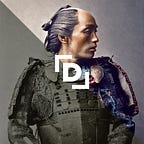Warrior 武士, 1881
Yokohama, Japan, 横浜 日本
This portrait of a soldier was taken during the Meiji Restoration, a period of technological and political upheaval in which Japan as a nation transformed from centuries of feudal rule to a consolidated political system under the Emperor of Japan. By the 1880’s, Japan had reversed its isolationist foreign policy and began to let European traders to conduct business.
この侍の肖像は幕藩体制から天皇を頂点とする中央集権化へと国家体制が変化し、科学技術と政治が大変動した明治時代に撮られたものです。1880年代までに日本は鎖国から開国へと政策を転換し、ヨーロッパとの貿易が開始されました。
The port of Yokohama became the base of foreign trade in Japan, and a centre of newly imported Western technology such as gas powered street lamps, newspaper and of course, photography. A number of photographic studios operated out of Yokohama, with the Japan Photographic Association (also known as Stillfried & Andersen) producing a prolific output of hand coloured portraits and landscapes.
横浜港は輸出額、輸入額が最も多く取り扱われる貿易の中心となり、ガス灯や新聞、写真技術など西洋からの科学技術が新たに輸入されました。数々の写真スタジオが横浜から開業され、日本写真社(シュティルフリード・アンド・アンデルセン)では職人の着色による肖像写真や風景写真を数多く生産しました。
Many photographs of daily life and portraits of a cross section of society were shot by known photographers of the time such as Felice Beato, and a number of Japanese photographers such as Kusakabe Kimbei (日下部 金兵衛) who developed their own techniques for hand colouring albumen silver prints known as shashin abura-e (写真油絵), were incredibly popular with tourists of the time.
日常写真や人物などの風俗文化写真を撮影し、この頃の日本の写真に大きな影響を与えたフェリーチェ・ベアトなどの写真家や、独自の技術で写真油絵として知られる手彩色アルビューメン•シルバープリントを発達させた日下部金兵衛などの日本人写真家の作品は当時、海外からの旅行客に人気の土産物でした。
I’m a huge fan of the shashin abura-e prints (‘photographic oil paintings’) where the paper support of the photograph was cut away and oil paints were applied to whatever emulsion was left over. The results are fantastic and in my opinion, far more realistic than many of the photo-mechanical colourised prints that became popular in the USA at the turn of the century.
私は写真油絵(印画紙の感光乳剤の膜の部分だけを残し、裏から油絵具で着色する技法を用いた作品)がとても好きです。アメリカで世紀の変わり目に発達していた写真製版法で色付けされたものよりも遥かになまなましい現実感あふれるイメージを得ることができる素晴らしい作品だと思います。
I’ve had a go at seeing what a modern attempt at colourising an original portrait would look like in similar photographic conditions, whilst retaining a painter-like quality that the early camera technologies afforded, along with the vibrant colours of the armour and clothing of the original hand coloured print, which would be close to the original dress colours and adjusted to fit the black and white information. If these are popular, I’d love to do a set, as Japanese clothing of the era could be very intricate.
私は現代技術で彩色したオリジナルの肖像写真を絵画のような要素を保って制作することを試みています。例えばオリジナル手彩色写真の鮮やかな色の甲冑や着物は実物の色に近いので、ほかの白黒の写真を彩色する際の参考としています。この時代の日本のイメージはとても細密で興味深いので、もっと多くの作品に挑戦したいと思っています。
Original Photograph | Franz von Stillfried-Ratenicz フランツ・フォン・シュティルフリード
Format | Albumen Silver Print
Source | Courtesy of the Capitol Collections キャピタルコレクションのご厚意により掲載させて頂いてます。
Color Reconstruction | Jordan Lloyd
Words | Jordan Lloyd, Kanae Takami Beasley
Original Caption
“A portrait of a Japanese soldier from the waist up. He is standing facing his left whilst wearing ornate armour consisting of a chest plate and chainmail undershirt. His hair is swept back and is dressed in a topknot.”イメージ解説
“日本武士の上半身の肖像。胸板と鎖帷子からなる装飾の施された甲冑を着用し、左を向いて立っている。髪は後ろへ流し、髷を結っている。”
